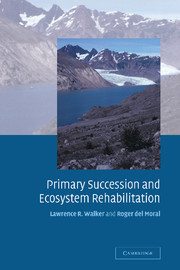Book contents
- Frontmatter
- Contents
- Preface and acknowledgements
- 1 Introduction
- 2 Denudation: the creation of a barren substrate
- 3 Successional theory
- 4 Soil development
- 5 Life histories of early colonists
- 6 Species interactions
- 7 Successional patterns
- 8 Applications of theory for rehabilitation
- 9 Future directions
- Glossary
- Illustration credits
- References
- Index
8 - Applications of theory for rehabilitation
Published online by Cambridge University Press: 08 January 2010
- Frontmatter
- Contents
- Preface and acknowledgements
- 1 Introduction
- 2 Denudation: the creation of a barren substrate
- 3 Successional theory
- 4 Soil development
- 5 Life histories of early colonists
- 6 Species interactions
- 7 Successional patterns
- 8 Applications of theory for rehabilitation
- 9 Future directions
- Glossary
- Illustration credits
- References
- Index
Summary
Theory of rehabilitation ecology
Introduction and definitions
Continual growth of the human population leads to declines in the quality of pastures, rangelands, farms and forestlands through erosion, salinization and desiccation. Further, the natural landscapes that provide many ecosystem services are rapidly being converted to agriculture, industrial and urban sites and even wasteland. The biodiversity and habitability of the planet is now more threatened than ever before. Therefore, it is imperative that degraded land is rehabilitated and that adjoining natural landscapes be protected. However, it is clear that degradation thresholds have been crossed in many habitats and succession alone cannot restore viable and desirable ecosystems without intervention (cf. Rietkerk et al., 1997). In this chapter, we explore rehabilitation ecology, applying lessons of the previous chapters. Processes of primary succession, from dispersal to interactions, are crucial for ecosystem recovery but have not been adequately evaluated for their applicability. Despite advances in the practical aspects of creating new habitats (Gilbert & Anderson, 1998), reclaiming degraded ones (Wali, 1992) and rehabilitating sites to productive uses (Dobson et al., 1997), restoration ecology remains in its formative stages. Rehabilitation offers hope for a better future, particularly when individual projects with limited scope can be integrated with larger conservation programs.
Even when faced with severe economic and time constraints, most practitioners aim beyond mere reclamation to provide valuable resources that include pastures, wildlife habitat and recreational land. They also strive to develop sites that contribute to biodiversity or that provide habitats useful for passive recreation.
- Type
- Chapter
- Information
- Primary Succession and Ecosystem Rehabilitation , pp. 282 - 327Publisher: Cambridge University PressPrint publication year: 2003

